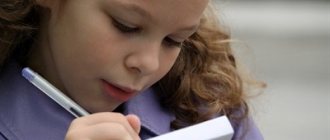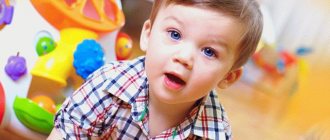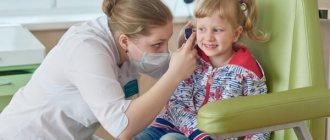What is active and passive vocabulary?
All the words that a child knows are his vocabulary (lexicon).
At the same time, those words that the baby understands, but does not pronounce himself, belong to the passive dictionary. And those words and phrases that are constantly used in everyday speech are included in the active one.
For example, if you ask a one-year-old baby “where is the cat?” and he points to the pet or the corresponding picture with his finger, which means the word “cat” is already in his passive dictionary. When the baby independently says “cat”, or “koska”, or any other sound that means a cat for the child, we can say that the word has become an active lexicon.
It is worth noting that the passive vocabulary is always larger than the active one, even in an adult. After all, each of us knows what society, quantum, molecule are, yet we almost never use these words in everyday speech.
How do the first words come about?
Every mother eagerly awaits her baby's first words. As a rule, all relatives are involved in the waiting process: mom, dad or grandma - which word will come first? Usually, the winner in this fight is the one who most often stands over the child’s crib, looks carefully into his eyes and clearly repeats: “pa-pa” or “ma-ma.” As a result, the child pronounces the cherished word, and the whole family celebrates the historical event! The child is bathed in applause, and he, satisfied, continues to babble the magical sounds that have caused so many positive emotions in adults. If you continue in the same spirit - look into the child’s eyes, clearly pronounce new words and just as emotionally rejoice at each new one - you will certainly be surprised at the dynamics of your baby’s speech development.
“Why exactly “dad”, “mom” and “baba”? The sounds that make up these words are classified as labiolabial and labiodental. They are formed with the help of lips and voice and are easiest for a child. In order for the baby to also easily develop front-lingual, mid-lingual and back-lingual sounds, add the “horse” exercise: click happily with him,” explains Olga Ivanova.
How to calculate the volume of active and passive vocabulary?
Finding out the approximate number of words in a passive dictionary is easy. It is enough to ask the child to show a certain object, action, object (for example, a cat). If the child did everything correctly, then the word is counted in the passive dictionary.
Now let’s calculate the size of the active dictionary. What should you consider?
1. Words that the baby pronounces clearly: “give”, “mom”, “dad”.
2. Sounds - imitation of animals, objects: car “beep-beep”, dog “woof-woof”.
3. Reproduction of incomplete words: “baka” – dog.
4. Words that are not pronounced correctly, but the number of syllables and stress are correct: “patina” - machine.
5. Words that are pronounced the same, but have different meanings (norm up to 2.5 years): “ma” - mom, car, meow (each word is counted separately).
To make it easier to count your active vocabulary and clearly see the progress and dynamics of your child’s development, I recommend that you keep a speech development diary . Every month you can enter the words that your baby has mastered. From 2.5-3 years old, keeping track of every word will be quite difficult due to the growing talkativeness. Then you can write down funny sayings from your baby in your diary, which you will be happy to re-read in the future.
1. Active vocabulary in its infancy. It consists of onomatopoeia, babbling words and only a small number of common words. The meanings of words are unstable and undifferentiated.
2. Passive vocabulary is wider than active, but understanding of speech outside the situation is very limited. Phrasal speech is almost completely absent.
3. The ability to reproduce the sound and syllabic structure of a word has not yet been formed.
Children who are at the level of babbling speech need a lot of preparatory speech work before they begin to systematically master school subjects. Children can receive such preschool training in a preparatory class at a speech therapy school.
At school age, children who do not speak at all or who are at the level of babbling speech are relatively rare, in cases where the conditions of everyday communication are unfavorable (unfavorable speech environment, characterological characteristics of the child, etc.). Most often, by the age of 7-8 years, children reach the second level of speech development.
Second level of speech development
characterized by the fact that the speech capabilities of children increase significantly; communication is carried out not only with the help of gestures accompanied by babbling fragments of words, but also through fairly constant, although very phonetically and grammatically distorted, speech means. Here is a story by Vitya M., 8 years old, based on the series of paintings “Two Little Goats”.
“Izhaya Uska Dasha. Kozik dostret and comb badasya. Badaisi, badaisi, fill the water.” (There was a narrow plank lying down. The goats were coming towards them and began to butt. They butted, butted, and fell into the water.)
As can be seen from the example, the stock of commonly used words becomes quite diverse; it clearly distinguishes words denoting objects, actions, and often qualities. At this level, children already use personal pronouns, occasionally prepositions and conjunctions in elementary meanings. There is an opportunity to talk more or less in detail about well-known events, about family, about yourself, about comrades. But the underdevelopment of speech still appears very clearly or even sharply: ignorance of many words, incorrect pronunciation of sounds, violation of the structure of the word, agrammatism, although the meaning of what is being told can be understood even without a visual situation. So, instead of the word clean, the boy says: “He shakes off his coat”; the word janitor is replaced by the explanation “Such a guy sweeps the floor.”
How many words should a child have in his active vocabulary?
The norms for the formation of the active vocabulary of a child of preschool and primary school age are as follows:
Thus, if at 1 year old a child normally pronounces no more than 10 words, then at 3 years old the child’s vocabulary is already about 1000 words. The vocabulary of a 5-year-old child is already about 2,000 words, and the vocabulary of a 6-year-old child is about 3,500 words. Don't panic if you suddenly find that your child is speaking fewer words than normal. Each child is individual and develops at his own pace. There are children who begin to speak closer to 2 years old, but understand everything already at 1-1.5 years old.
If you still have doubts or questions about your baby’s development, for your own peace of mind, consult a specialist. As a rule, the inclusion of certain games for the development of vocabulary in spending time together is enough for the child to catch up and even surpass his peers.
How to help your child develop vocabulary?
As you already understand, a child’s vocabulary begins with the passive part, and it, in turn, is formed from birth, therefore:
⇒ communicate with your baby. Talk not only to each other, but also purposefully with him. Pronounce words clearly, slowly, construct sentences as correctly as possible and do not “swallow” endings;
⇒ comment all around. Go to the kitchen with the baby, tell us what you will do now, and when you pick up any object, be sure to say its name, color, shape;
⇒ do not replace spoken language with TV or radio. A child needs a “living” environment to learn a language.
Features of vocabulary development in play activities of preschool children
“Features of vocabulary development in the play activities of preschool children”
A dictionary is the lexical composition of speech that a person uses. The dictionary is divided into active and passive.
Passive vocabulary is words that the speaker understands, but does not use himself. The passive vocabulary is much larger than the active one; this includes words whose meaning a person can guess from the context.
Active vocabulary is words that the speaker not only understands, but also uses. The child’s active vocabulary includes commonly used vocabulary, but in some cases a number of specific words, the everyday use of which is explained by the child’s living conditions.
Tasks of dictionary work:
Enriching children's vocabulary with new words, mastering previously unknown words, as well as new meanings for a number of words already in the lexicon. The enrichment of the vocabulary occurs, first of all, due to commonly used vocabulary.
Consolidation and clarification of vocabulary. In children, the word is not always connected with the idea of the object. They often do not know the exact names of objects. Therefore, it is necessary to deepen the understanding of already known words and fill them with specific content.
Activation of the dictionary. It is important that the new word enters the active vocabulary. This happens only if it is consolidated and reproduced by them in speech. A new word should enter the dictionary in combination with other words so that children get used to using them in the right cases. Therefore, activating the dictionary is an increase in the number of words used in speech, the content of which is accurately understood by the child. K.D. Ushinsky wrote about this task as follows: “...Recalling words and forms of language from children’s memory is very useful: children’s stock of words and forms of their native language is usually not small, but they do not know how to use this stock, and it is this skill that they need to find quickly and correctly in memory the required word and the required form is one of the most important conditions for the development of the gift of speech.”
Enriching vocabulary is a necessary condition for the development of children's communication skills.
The richer and more correct a child’s speech, the easier it is for him to express his thoughts, the wider his opportunities for understanding the surrounding reality, the more meaningful and fulfilling his relationships with peers and adults, the more active his mental development is.
Poor vocabulary hinders full communication, and therefore the overall development of the child. Conversely, a rich vocabulary is a sign of well-developed speech and an indicator of a high level of mental development. Timely development of vocabulary is one of the most important factors in preparing for school education.
Thanks to various types of activities, and, above all, play, the child’s speech becomes voluntary and purposeful.
The game has a very great influence on the development of speech. The game situation requires from each child included in it a certain level of development of verbal communication. If a child is not able to clearly express his wishes regarding the course of the game, if he is not able to understand his playmates, he will be a burden to them. The need to communicate with peers stimulates the development of coherent speech.
The vocabulary activation techniques most often used in working with children of senior preschool age include the following:
— Verbal didactic exercises: “Who will say more precisely?”, “Who will notice more (qualities, signs, details)?”, “Who will tell in more detail?”, “Who will say otherwise?” (an exercise for selecting synonyms), “Indicate the opposite quality, direction” (or “Say the opposite” - for the use of antonyms). Games can be played using a ball (“What kind of apple?” asks the teacher and throws the ball to the child. “Sweet,” he answers and returns the ball. “The apple is sweet and ...?” - the teacher throws the ball to another child. “Fragrant (juicy, yellow, Antonov)." Or the teacher throws the ball with the words: “He works at a construction site, but is not a painter.” “A bricklayer (plasterer, carpenter, plumber, etc.),” the child answers.
Play is the main activity of a child in preschool age; by playing, he learns about the world and people; by playing, the child develops.
An important means of developing the vocabulary of preschool children is a didactic game. The methodology for conducting vocabulary didactic games is determined by the content of vocabulary work, the age characteristics of children and the ability to regulate their actions. Inner speech is formed.
For the most part, adults who want to teach a child to speak correctly use one method - they ask them to repeat the word they just said. However, this method is not the most successful for speech development. Adults who really want not only to teach a child to imitate them, but also to ensure that he perceives the world around him through these words, can use simple didactic exercises in their practice.
Vocabulary didactic games help the development of both specific and generic concepts, the development of words in their generalized meanings. In these games, the child finds himself in situations where he is forced to use previously acquired knowledge and vocabulary in new conditions.
The selection of material for didactic games should be determined by the tasks of vocabulary work. To activate the everyday vocabulary, toys or pictures depicting household items are selected. To activate the natural history vocabulary, natural material is selected. One of the conditions for clear management of games is to determine the list of words to be learned.
With the help of didactic games, a child can acquire new knowledge: by communicating with the teacher, with his peers, in the process of observing the players, their statements, actions, acting as a fan, the child receives a lot of new information. And this is very important for its development.
In the game, the child learns to understand the purpose of various things and objects, to find connections with adults and other children.
Didactic games with toys are widely used: “Find the toy”, “Guess the toy by touch”, “Find out what has changed”, etc. Games are played for different purposes. Depending on which words are clarified and reinforced, the teacher selects toys. Usually they use 2 - 3 toys that are pre-considered. In the process of examination, the vocabulary is clarified, and in the process of subsequent play, it is activated. The game also combines education and entertainment.
Didactic games are educational games that can be used to enrich children's vocabulary. They are also used to consolidate children's vocabulary (nouns, adjectives, verbs, color names, spatial concepts, prepositions, etc.). Speech, memory, attention, logical thinking, visual memory develop. A culture of behavior and communication skills are strengthened. To develop and enrich a child’s vocabulary, educators widely use role-playing games.
Thematic role-playing game has a positive effect on the development of speech.
Role-playing play plays a special role in the life of a child, especially a preschooler; it allows the child to imagine himself as a doctor, hairdresser, mom or dad, and allows him to develop imagination, thinking, and fantasizing.
In role-playing games, the child tries to express himself as clearly as possible, to apply all his accumulated experience, all his knowledge and skills.
Theatrical games have a great influence on the development of the vocabulary of preschool children. By participating in theatrical games, children get acquainted with the world around them through images, colors, and sounds. Theatrical and play activities enrich children with new impressions, knowledge, skills, develop interest in literature, activate the vocabulary, and contribute to the moral and ethical education of each child.
In the process of working on the expressiveness of characters’ remarks and their own statements, the child’s vocabulary is imperceptibly activated, and the sound side of speech is improved. A new role, especially the dialogue of characters, confronts the child with the need to express himself clearly, distinctly, and intelligibly. His dialogic speech and its grammatical structure improve, he begins to actively use the dictionary, which, in turn, is also updated.
The vocabulary of preschoolers is actively enriched by words “invented” by them (“pretty”, “naked”, “mazeline”). Word creation is the most important feature of children's speech. Facts collected by psychologists, teachers, and linguists indicate that the period from two to five years is characterized by active word creation in children. Moreover, new words are constructed according to the laws of language based on imitation of the forms that they hear from surrounding adults. Word creation is an indicator of the mastery of the morphological elements of a language, which are associated with the quantitative accumulation of words and the development of their meanings.
So, good speech is the most important condition for the comprehensive development of children. The richer and more correct a child’s speech, the easier it is for him to express his thoughts, the wider his opportunities for understanding the surrounding reality, the more meaningful and fulfilling his relationships with peers and adults, the more active his mental development is. The development of speech - its sound side, vocabulary, grammatical structure - is one of the most important tasks in teaching children.
A significant place in teaching speech is occupied by vocabulary work: expanding the vocabulary, clarifying the meanings of words, activating passive vocabulary. Since play is the leading activity of a preschooler, it is necessary to use various games and play exercises in developing the child’s vocabulary.
The most powerful engine of speech development is activity. A little person, like adults, has work and play. This is the most natural and easiest way for a child to master speech. While playing, the baby remembers the names of various objects, learns to characterize and verbalize the actions that can be performed with these objects.
All actions that you perform together with your child and objects associated with them require verbal accompaniment.
Vocabulary and grammatical structure develop and improve constantly, not only in preschool age, but also during schooling.
Despite the increasing vocabulary, the growth of the vocabulary lags behind the growth of ideas, and a gap appears between the passive and active vocabulary. Hence the abundance of demonstrative pronouns and adverbs in children’s speech (that, that, there, that way).
Attention should be paid to the correct understanding of words, their precise use according to their meaning, and expansion of the active vocabulary; when comparing objects, learn to identify and accurately identify essential features; activate words denoting qualities and actions. It is also important to enrich children’s speech with adjectives based on expanding and deepening their ideas (fox - red, cunning, careful).
Conclusion
In preschool age, a child must master a vocabulary that would allow him to communicate with peers and adults, study successfully at school, understand literature, television and radio programs, etc.
Preschool age is a period of active acquisition by a child of spoken language, the formation and development of all aspects of speech: phonetic, lexical, grammatical. Full command of the native language in preschool childhood is a necessary condition for solving the problems of mental, aesthetic and moral education of children in the most sensitive period of development. The sooner learning the native language begins, the more freely the child will use it in the future.
Scientific research by a number of psychologists and educators has shown that preschool childhood is especially sensitive to speech acquisition.
The development of children's speech and vocabulary, mastery of the riches of their native language is one of the main elements of personality formation, mastery of the developed values of national culture, is closely related to mental, moral, aesthetic development, and is a priority in language education and training of preschool children.
The development of a dictionary is understood as a long process of mastering the vocabulary accumulated by a people in the course of its history.
Used Books:
A.M. Borodich Methods for developing children's speech Publishing house "Prosveshchenie",
S.A. Mironova Speech development of preschool children in speech therapy classes., Moscow “enlightenment”,
Prepared by: Shumkina S.P.








